Accent HT-400 HTPC Case Installation Instructions
Revision 1.1 © 2005 Quietpc.com, written by Paul Lee
These instructions guide you how to install your new HT-400 in an easy-to-follow manner. You may like to print out these instructions so you can refer to them while building the PC. However, if you are in any doubt as to your own competency in PC hardware installation then for the safety of yourself and your PC, please ask an expert engineer to do the work for you! These instructions are for guidance only and no responsibility or liability can be borne by QuietPC.com for damage or loss incurred, (including data loss) howsoever caused, either directly or consequentially.
IMPORTANT: If you are transferring an old PC into the HT-400 chassis then it is essential that you back-up the data on your hard drive. You should be in the habit of doing this regularly in any case, as hard drives are never 100% reliable and total data loss can be disastrous if no other copy exists. The hard drive is at a higher than normal risk of failure due to accidental damage while a PC upgrade is in progress.
1. Getting Started
Remove the outer casing by unscrewing the four screws located at each side of the case. You can then easily raise the outer casing away from the chassis. It is easier to build the PC if you remove the 5.25” and 3.5” bay holders, it just gives you more room to manoeuvre when installing the motherboard etc. The bay holders are held on by four screws, you will need a screwdriver at least 4” long to be able to remove the 5.25” bay holder. Image #1 shows the case without the 5.25” bay holder.
TIP: If you intend to install the optional VFD it is best to do so now, before you reinstall the 5.25” bay holder.
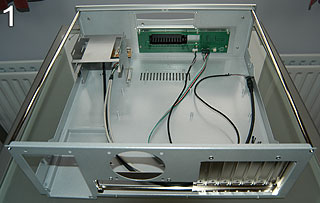
2. Installing Components
Installing the components into the HT-400 is reasonably straightforward and very similar to any other desktop PC, apart from the optical drives, which we will covered later. Before you connect the power supply to your motherboard, don’t forget to install the small ATX extension cable supplied with the iMON. This will allow you to power on your PC with the remote. See the iMON instructions (supplied) for more information.
TIP: While installing the components it is always good to think about where you intend to place any excess wires. If you have no regard to what you do with any excess wires it can have a negative effect. Wires left lying around can reduce airflow inside the system, so it is always best to carefully and neatly place the wires where they will not block airflow. You will notice from some of the pictures below that I used the space directly under the hard drive to hide any excess wires.


3. Choosing the Correct Optical Drive
Unfortunately not all optical drives are compatible with the HT-400. There are two points to consider when choosing an optical drive.
-
The length of the drive - This is because it may collide with the VGA card. The maximum recommended length for an optical drive is 190mm, see image #4. The length of the graphics card installed in image #4 is 171mm (PCB length). If your optical drive is smaller than 190mm then you can use a longer VGA card. The combined length of the optical drive and the VGA card is recommended not to exceed 365mm.
-
Front of CD try - If the front of the CD tray is 9mm tall, as shown in image #5, then there should not be any problems. If the front is larger, like the other optical drive shown, it raises the aluminium bezel supplied with the HT-400 and therefore it does not fit the case correctly. The top drive in image #5 is a NEC 2510A DVD/RW, while the bottom is a Plextor PlexCombo 20/10/40-12A.
If you have used an optical drive that fits the HT-400 and is not mentioned below please email me and I will add it to the list of compatible drives.
Compatible optical drives include - NEC 2500A/2510A/3500A/3520A/3540A DVD/RW, LG GSA-4081B DVD/RW, MSI D16, TEAC CD-552E.
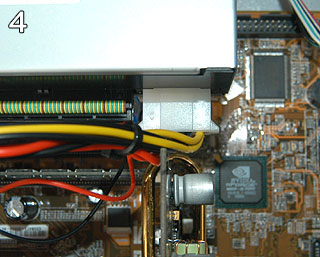
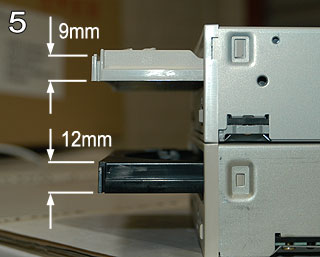
4. Installing an Optical Drive
Unfortunately there are two different types of 5.25” bay holders. One has an open top (as shown in image #6), while the other does not. All this means is that you need to unscrew and remove the 5.25” bay holder that does not have the open top.
Before installing the optical drive you will need to remove the plastic bezel from the CD tray, as shown in image #6 and highlighted in image #7. TIP: You can open the CD tray without power! Just push a paper clip (or something similar) down the hole circled in image #7, this will open the CD tray slightly, allowing to open it further with your fingers. Once the optical drive is placed in the bay holder you will notice a recess in the inside of the case where the front of the optical drive sits. Make sure the optical drive is pushed as far in as possible, this will help you install the aluminium bezel correctly.
Now that the drive is in place it is time to install the aluminium bezel. Peel back one of the adhesive strips and stick it to the back of the bezel. Then peel back the other side of the adhesive strips, the bezel is now ready to be stuck onto the front of the CD tray. To do this make sure the CD tray stands about 1” out of the drive, as shown in image #6. TIP: It is easier to install the bezel if your eye level is the same as the CD tray, this allows you make sure you align the bezel correctly. Once installed the CD tray should close and the gap around the bezel and the edge of the case should be consistent. If not try re-sticking the bezel, but be careful when you remove it. You ideally want to get this right first time!
Finally, if one side of the bezel stands out further than the other all you need to do is slightly unscrew the retaining screws holding the drive in place (you may need to remove the 3.5” bay holder to do this) and move the drive until it looks correct, then tighten up the screws.
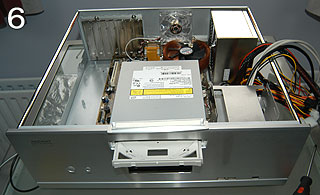

5. Installing the Optional VFD and iMON Hardware
VFD - If you are planning to install the optional VFD then this is the time to connect it all together. Installation is straightforward, just follow these steps.
1. Feed the end of the cable through a PCI slot that connects to the VFD. 2. Connect the cable to the VFD, making sure it is the correct way around. The thick black and red cables need to at the bottom, see image #8. 3. Connect the other end of the cable to the parallel port. 4. Finally, connect the molex connector that powers the VFD to a free 4-pin hard drive connector from the power supply.
iMON - Installing the iMON hardware is very easy. We have already mentioned the small ATX extension cable that enables you to be able to power-on your PC with the remote. All other hardware should be connected without any problems. Please refer to the instructions supplied, or alternatively you can download the user manual here (11Mb PDF). When installed correctly you should be able to turn your PC on and off with the remote controller.
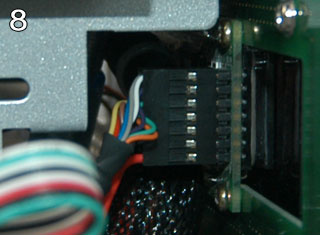
5. Software Installation
iMON Software - Once you have your operating system up and running and all your hardware is installed correctly you can then install the software supplied with the iMON, this is called Multi-Median. Again, instructions are supplied to help you do this. There is also a user manual for your reference.
VFD Software - The best software I have found to use with the VFD is LCD Smartie. Their website provides lots of information to help you configure the software with most programs. You will also need to download and install port95nt.exe, you can do so here. Once the LCD Smartie software is installed, just follow the instructions supplied with the software.
Things would not be complete without a few pictures of the final product!
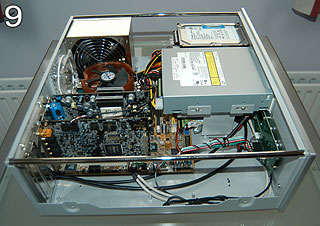

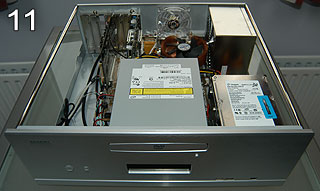
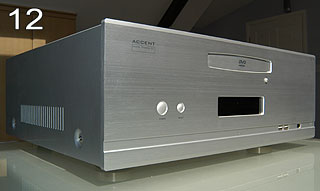
Other Resources
Home Theatre PCs are becoming more and more popular and therefore there are hundreds of websites that are designed to offer help and advice. Here are just a few…
AVS Forum, US Based, AV Forums, UK Based, HTPC News, US Based.
If you know of any other sites that you think should be added to this list, please let me know.
Products Used
Here is a list of all the Quiet PC products used in this feature.
Accent HT-400 Silver, CNPS7000A-CU AMD CPU cooler (see new CNPS7000B-CU), QTechnology 350W, with 120mm fan power supply, Sapphire 9600XT Ultimate 128MB graphics card, 80mm AcoustiFan, temperature sensitive, Beige NEC 2510A- DVD/RW, Seagate 80GB IDE hard drive, and finally a VFD.
